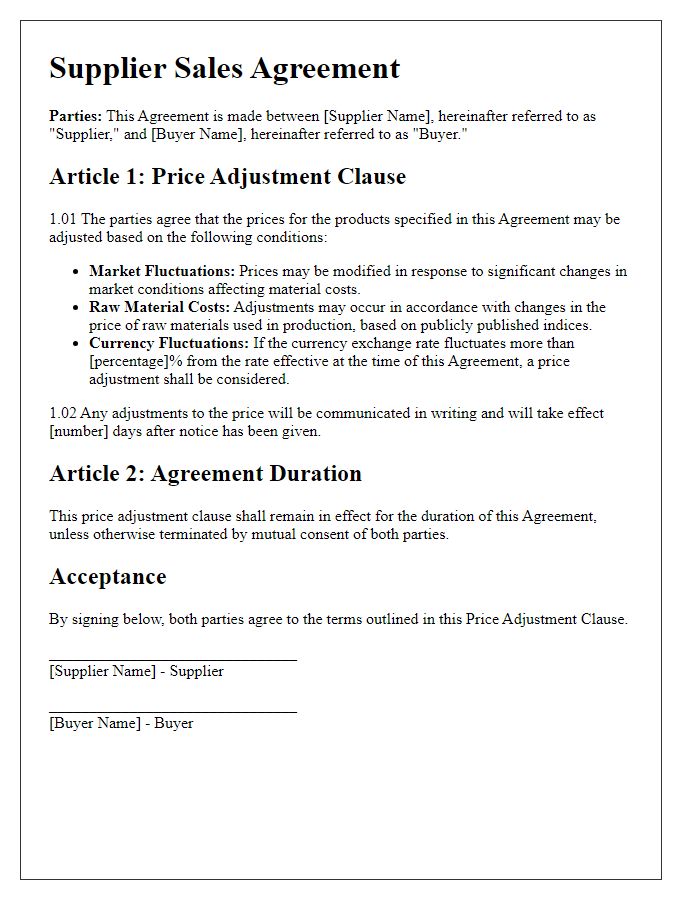When it comes to establishing a solid foundation for a successful partnership, a well-crafted supplier sales agreement is crucial. This document not only outlines the terms of sale but also clarifies expectations, ensuring smooth transactions between both parties. By understanding essential components like pricing, delivery schedules, and payment terms, you can foster a more transparent and efficient relationship. Ready to dive deeper into how to create an effective sales agreement? Keep reading to discover the key elements you need to include!

Payment Terms
A supplier sales agreement solidifies the transaction framework between companies and vendors, detailing critical components such as Payment Terms. Specifying net payment conditions is vital, indicating the number of days (typically 30, 60, or 90 days) after the invoice date when payments are due. Clear definitions of accepted payment methods (such as bank transfer, credit card, or check) can prevent misunderstandings. Discounts for early payments (e.g., 2% off if paid within 10 days) can incentivize prompt financial interactions. Additionally, penalties for late payments (often around 1.5% per month) serve as a deterrent. Currency specifications, especially in international agreements, must be articulated to avoid exchange rate complications, ensuring all parties operate on the same financial basis.
Delivery Schedule
The delivery schedule outlines the timeline for the shipment of goods or services between suppliers and buyers. Each delivery date must be clearly specified in the agreement, indicating milestones such as initial shipments, regular intervals, and final delivery. For instance, if a supplier is contracted to deliver 1,000 units of a product to a warehouse located in Los Angeles, California, the timeline should detail whether deliveries occur weekly, bi-weekly, or monthly. Terms must address possible delays caused by factors like natural disasters or logistical challenges, including shipping routes or customs clearance. Payment terms upon delivery completion, such as net 30 or net 60 days, should also be included to ensure both parties understand their obligations.
Product Specifications
Product specifications play a crucial role in defining the quality and features of goods supplied under a sales agreement. These specifications include detailed descriptions of materials, dimensions, functions, and performance standards. For instance, a supplier may provide information on the grade of stainless steel used in manufacturing kitchen equipment, ensuring it meets industry standards such as ASTM A240. Additionally, specifications should outline compliance with relevant regulations, such as safety certifications from organizations like UL (Underwriters Laboratories) for electrical appliances. Accurate product specifications facilitate clear communication between suppliers and buyers, ensuring both parties have a mutual understanding of what is being delivered. Furthermore, including tolerances and testing procedures can prevent disputes and enhance quality control, ultimately leading to improved customer satisfaction.
Termination Conditions
Termination conditions in supplier sales agreements establish the circumstances under which either party can dissolve the contract. Common conditions include significant breaches of contract, such as failure to deliver products as agreed or non-payment within specified timeframes, typically ranging from 30 to 60 days. Additionally, either party may terminate the agreement with a written notice period, usually 30 days, allowing for proper transition and resolution of outstanding issues. Force majeure events, such as natural disasters affecting supply chain logistics, can also allow for termination without penalties. Legal compliance, such as adherence to local regulatory requirements, may be stipulated as a condition for continuing the agreement, ensuring both parties maintain ethical and operational integrity throughout their partnership.
Liability and Warranty
A supplier sales agreement includes critical terms such as liability and warranty that ensure a clear understanding between the supplier and the buyer. Liability clauses detail the responsibilities of the supplier, often outlining limits on damages, typically not exceeding the purchase price (for example, $10,000). Warranty provisions define the timeframe (commonly 12 months) during which the supplier guarantees that products meet specified standards and performance criteria. These sections may include provisions for defects and the remedies available to the buyer, such as repair, replacement, or refund policies for faulty goods. Additionally, any third-party liability related to the use of the products may also be addressed, ensuring both parties understand potential risks and responsibilities. Overall, these terms are vital for establishing a fair and equitable relationship, safeguarding both supplier and buyer interests.
Letter Template For Supplier Sales Agreement Terms Samples
Letter template of supplier sales agreement terms for exclusive distribution

Letter template of supplier sales agreement terms for price adjustment clauses

Letter template of supplier sales agreement terms for delivery logistics

Letter template of supplier sales agreement terms for cancellation policies










Comments